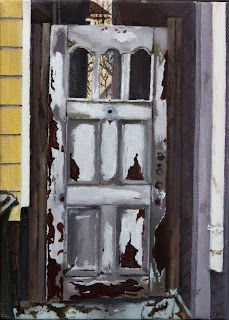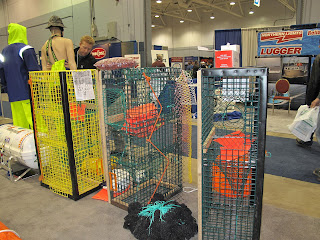I imagine that every maker has his/her favourite tools and materials: metal knitting needles vs. bamboo ones; ash vs. maple; oil paint vs. acrylics; silver vs. gold. A skilled technician can work with virtually any tool and any material, but you want the ones that make your heart sing while you work.
I have some old linocutting materials and tools that were gifted to me after a friend's mother moved on from them. I also have some new materials and tools I picked up at NSCAD. I have my NSCAD experiences with printmaking, few and brief as they are, but they left a small legacy from which I can draw. I have my own needs and desires concerning how I want to work and the results I want to achieve. The upshot is that this short printmaking journey has also involved an exploration of tools and materials, completely unexpected when I began but unexpectedly enlightening.
I started with a piece of old lino and my high quality carving tools, really intending for wood carving. The
Tree Swallow plates were all done with lino and using those tools. At my nascent skill level, I find it tricky to carve fine details into lino, especially the small areas that will print black. The lino tends to "fail" when too much is carved away from a small section that you want to remain. I succeeded with the
Tree Swallow plates, but felt uncomfortably close to the brink of disaster several times along the way.
Briefly at NSCAD, I was enrolled in a relief printing course that I eventually had to drop because of schedule overload. There, I was introduced to Sintra, a plastic that comes in large sheets and whose intended purpose is for sign-making... and which carved like butter. I tracked down the few small scraps I'd saved from the course, carved a few trial strokes and was instantly converted. Thence began a rather fraught search to find more. I approached a sign maker in Saint John and was given an armload of cutoffs only to discover that while they looked like the real thing, they behaved differently. Sintra is forgiving, they were not. I tried the internet, where the cost of shipping was about five times the (exorbitant) cost of an artist-sized piece. I contacted the US manufacturer who directed me to a wholesaler in Moncton, but the wholesaler didn't carry Sintra despite what the manufacturer thought. I tried another Saint John sign maker. He disappeared doubtfully into recesses of his warehouse and eventually emerged with a partial sheet, the last of his (obsolete) stock.
Thankfully, it's a large enough amount that if I keep working small, get the drawings right the first time and take care to get the orientation right, it should last for a while. Meanwhile, NSCAD's printmaking department directed me to another source for the next time I make the four-hour drive to Halifax. And suggested an alternative, Marmoleum, which again led to hours spent on the internet. Eventually I got my hands on a 13" square tile although it's only 1/16th inch thick, which doesn't give much leeway for relief carving. I'll try it eventually; haven't had time -- or the courage -- yet.
The point is: while someone else may prefer lino and know all the special techniques for making it sing -- like heating it up before carving -- my current love affair is with Sintra because of the fine lines it accommodates.
Side-yard Gate was carved into Sintra, and I would have despaired of achieving the long straight lines in that drawing had I tried to work it in lino, at my current, limited skill level.
While we're talking about materials, let me mention the papers onto which prints are made. Who knew there is so much to know about papers? The paper onto which my linocut prints were made is Somerset, which has a smooth, velvety surface. The copperplate etchings were also made on a much different Somerset paper with a harder, slightly textured surface. Somerset is hardly the only paper on offer; there's Stonehenge and Arches, only two that I've encountered and there are many more. How to choose? Eventually, I imagine, a person settles on the one that works for him/her and ignores the temptations of the rest, just to keep life somewhat under control given all the possibilities.
Then there are inks. The first draft of
Tree Swallow was made using hand-me-down Speedball water-based ink. I can only hope that their formulas have improved; the tube I have must be at least 20 years old, possibly more. I hated the results. Next, I ordered some soy-based ink that cleans up with water, which I used for the second draft of
Tree Swallow. Much, much more satisfying. But the siren call of the rubber-based ink I used at NSCAD held me in its thrall... not finding a reasonable (affordable) online source, I turned to a retired printer I know here in St. Martins who tracked down a small amount for me to use. Ooo, the smoothness with which the ink rolled onto the plate; ooo, the rich black on the paper; but arg, the ensuing clean-up! It begins with vegetable oil... and here I mention that there is no running water at the studio. I had to take the slippery, inky-oily plate and tools home to finish the task. Yikes!
In the copperplate etching course, we used an oil-based ink that had qualities similar to those of the rubber-based ink, but in the properly equipped Saint John Art Centre printing studio, the clean-up was a comparative breeze. Health and environmental advocates endorse the water soluble inks over the oil- or rubber-based, and their concerns are legit. But ooo, those rich blacks! The heart has a say in the matter too.
Now we turn to tools and let me start with the baren, essentially a smooth pad with a handle above it that is slid across the paper while pressure is applied from above. Mine is simple and inexpensive: a very fine metal screen on the bottom of the pad and a plastic handle with a good grip that arches over the top, reminiscent of a shovel handle. The baren originates in Japanese woodblock printing and traditionally is surfaced with bamboo leaves. They're still made and used today, and are touted as superior, so I went shopping online. Having been assured that you-get-what-you-pay-for in bamboo barens, I bypassed the ones costing less than $10 and went looking for something of (presumed) better quality. The next price range I found was $1,000+; nothing in the middle. It would be fascinating to watch a skilled Japanese printer demonstrate the differences between a $10 baren and a $1,000+ one. Needless to say, I won't be trying the experiment myself.
I already have enough to explore with my lino carving tools: a hand-me-down Speedball set with a plastic handle and disposable blades, and a Flexcut carving set with 10 (razor-sharp!) blades and a sharpening kit. I felt so superior using the Flexcut kit, clumsily trying to follow the sharpening kit instructions, until I read a post online that said forget your fancy woodcarving tools, lino-carving dulls them too quickly, stick to the Speedball disposables for the best results. Okay, my personal jury is still out, but next up on my shopping list will be a supply of disposable blades for the Speedball set so I can really explore the differences.
Copperplate etching requires a different kind of tool. Bob lent us proper etching needles owned by the Saint John Art Centre so we could work on our plates between his classes. But he had kindly allowed me to try one of his own tools, a modified dental pick... and it was so vastly superior in its mark-making that I sought and gratefully accepted the loan of it for the week. The results were so gratifying that instead of immediately plunging into a re-working of the salt marsh print after the course ended, I plunged into a search for dental tools. My dentist claims his clinic gets its tools re-sharpened, so I took to the internet again. Eventually I found what I wanted, unexpectedly cheap, delivered promptly from Ontario, and got a machinist friend to grind it down into the right shape for an etching scribe.
I hope you're getting the point of all of this: in attempting to make prints, I had no idea I was embarking on a technical (and online shopping) journey as well as an artistic one. I had no idea at the outset that the technical issues would make such a difference, not just to the artistic results but to my enjoyment of the process. I like the feel of the Flexcut tools in my hand and the challenge of trying to keep them sharp; the buttery, easily carved Sintra; the sticky blackness of the ink on the glass plate and roller; the velvety surface of the Somerset paper; and the physicality of turning the handle of the Saint John Art Centre etching press. Tools and materials matter, not only for the quality of the results they produce but for how they feel to the hand, and how they make you feel inside. My advice to all makers: explore, explore, explore and find the ones that make your heart sing!




































